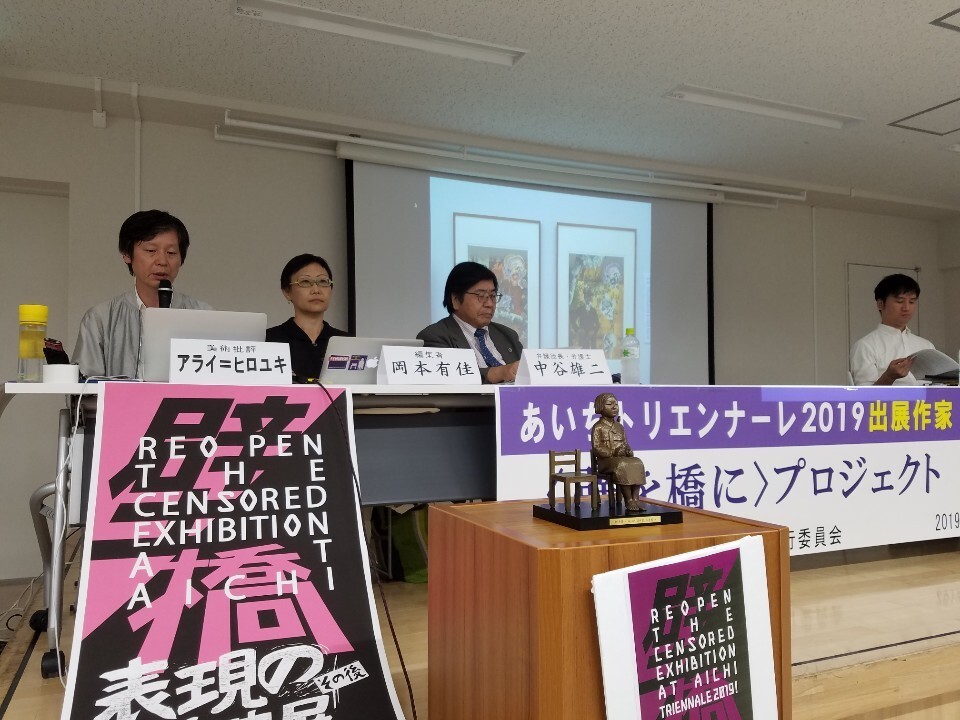hankyoreh
Links to other country sites 다른 나라 사이트 링크
Comfort woman exhibition organizers engage in legal battle with Aichi Prefecture

The recent closure of a Japanese exhibition that featured a comfort woman statue is developing along similar lines as Nikon’s cancellation of a photography exhibition about the former comfort women in 2012. A battle in the courts may make it possible for the “Statue of a Girl of Peace” to be put on display once again.
The members of the executive committee for the exhibition in question (called “After ‘Freedom of Expression?’”) held an indoor assembly in Tokyo’s Bunkyo Ward announcing the initiation of a project called “Walls into Bridges.” During the assembly, the committee members explained how they had filed an injunction demanding that Aichi Prefecture, which is hosting the Aichi Triennale, reopen the exhibition and asking the public for support.
Attorney Yuji Nakatani, who heads the executive committee members’ legal team, explained, “We filed for an injunction with Nagoya District Court on Sept. 13 to have the 3m wall at the entrance of the ‘After Freedom of Expression?’ exhibition venue removed and the exhibition resumed.”
An injunction application was also the legal response taken in 2012 after the suspension of photographer Ahn Se-hong’s exhibition of photographs related to the comfort women survivors at the Nikon Salon, an exhibition venue operated by the camera company Nikon. In May 2012, Nikon cancelled the exhibition “Comfort Women in China,” which had been scheduled to take place from June 26 to July 9 that year. But the exhibition ended up going on as scheduled when Tokyo District Court agreed to Ahn’s request for an injunction to demand that he be allowed to use the exhibition venue as agreed upon. Ahn later filed suit against Nikon to demand damages, and in 2015 Tokyo District Court ordered the company to pay him 1.1 million yen (US$10,197) in compensation.
“There are quite a few similarities between the Nikon case and this one,” said Lee Chun-hee, a Zainichi Korean attorney who was a member of the legal team for both the Nikon Salon case and the latest comfort woman statue exhibition case, at the assembly that day.
“The difference is that Nikon is a private company, while this case involves a public institution, namely Aichi Prefecture,” Lee explained.
Aichi Triennale scheduled to close on Oct. 14Another difference is the little time remaining. The Aichi Triennale event is scheduled to run through Oct. 14. Aichi Prefecture has not responded on the issue of resuming the “After ‘Freedom of Expression?’” exhibition, calling instead to wait for an inspection committee’s findings. But Hiroyuki Arai, an art critic and member of the “After ‘Freedom of Expression?’” executive committee, has claimed there are issues with the inspection committee’s method of operation and composition. As an example, he noted a recent tweet by inspection committee member Shinichi Ueyama, who wrote, “The very inclusion of a comfort woman statue in ‘After Freedom of Expression?’ appears to constitute political propaganda, and together with the other works in particular, it presented a clear risk of coming across as a left-wing design.”
Yuka Okamoto, another executive committee member, said, “Censorship is said to be completed once it is internalized [by those subject to censorship], which is what we need to stop.”
“The artwork is still there inside the exhibition venue; there is just a 3m wall in front of it now,” Okamoto added. “We need to tear down the wall and build a bridge.”
Kozo Nakata, an executive committee member, said, “You can’t light up all around you with a single match. But a single match can tell you how much darkness there is around you.”
“The deep darkness in Japanese society is something faced not only by the artists and executive committee members, but also by the Japanese media,” Nakata said.
By Cho Ki-weon, Tokyo correspondent
Please direct comments or questions to [english@hani.co.kr]

Editorial・opinion
![[Editorial] Intensifying US-China rivalry means Seoul must address uncertainty with Beijing sooner than later [Editorial] Intensifying US-China rivalry means Seoul must address uncertainty with Beijing sooner than later](https://flexible.img.hani.co.kr/flexible/normal/500/300/imgdb/original/2024/0517/8117159322045222.jpg) [Editorial] Intensifying US-China rivalry means Seoul must address uncertainty with Beijing sooner than later
[Editorial] Intensifying US-China rivalry means Seoul must address uncertainty with Beijing sooner than later![[Column] When ‘fairness’ means hate and violence [Column] When ‘fairness’ means hate and violence](https://flexible.img.hani.co.kr/flexible/normal/500/300/imgdb/original/2024/0516/7417158465908824.jpg) [Column] When ‘fairness’ means hate and violence
[Column] When ‘fairness’ means hate and violence- [Editorial] Yoon must stop abusing authority to shield himself from investigation
- [Column] US troop withdrawal from Korea could be the Acheson Line all over
- [Column] How to win back readers who’ve turned to YouTube for news
- [Column] Welcome to the president’s pity party
- [Editorial] Korea must respond firmly to Japan’s attempt to usurp Line
- [Editorial] Transfers of prosecutors investigating Korea’s first lady send chilling message
- [Column] Will Seoul’s ties with Moscow really recover on their own?
- [Column] Samsung’s ‘lost decade’ and Lee Jae-yong’s mismatched chopsticks
Most viewed articles
- 1[Editorial] Transfers of prosecutors investigating Korea’s first lady send chilling message
- 2[Exclusive] Unearthed memo suggests Gwangju Uprising missing may have been cremated
- 3[Column] US troop withdrawal from Korea could be the Acheson Line all over
- 4Xi, Putin ‘oppose acts of military intimidation’ against N. Korea by US in joint statement
- 5[Column] When ‘fairness’ means hate and violence
- 6‘Shot, stabbed, piled on a truck’: Mystery of missing dead at Gwangju Prison
- 7[Editorial] Intensifying US-China rivalry means Seoul must address uncertainty with Beijing sooner t
- 8Spotlight turns to Hyundai Group Chairwoman’s visit to North Korea
- 9[Column] Samsung’s ‘lost decade’ and Lee Jae-yong’s mismatched chopsticks
- 10[Column] Will Seoul’s ties with Moscow really recover on their own?